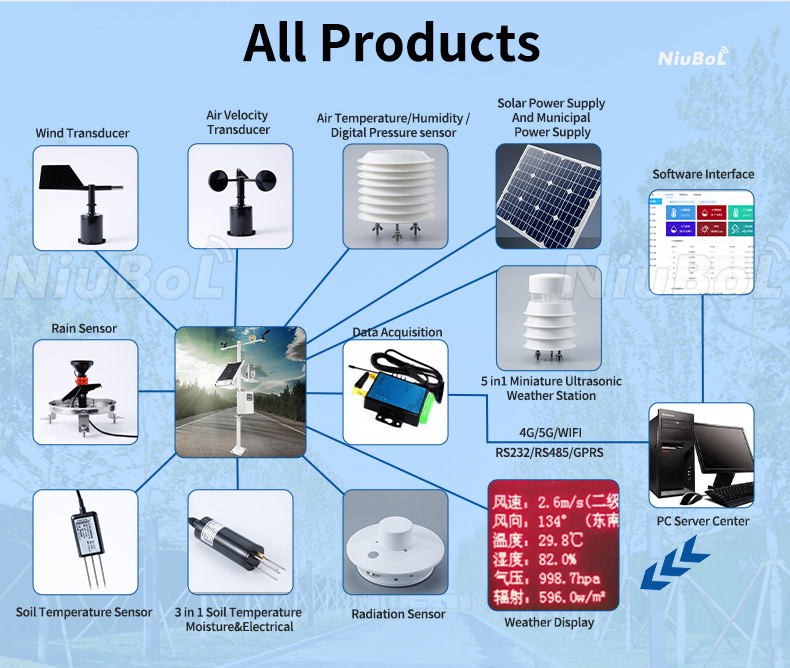

— Products —
 Consumer hotline +8618073152920
Consumer hotline +8618073152920 WhatsApp:+8615367865107
Address:Room 102, District D, Houhu Industrial Park, Yuelu District, Changsha City, Hunan Province, China
All products
Soil temperature and moisture sensors are devices used to measure the internal temperature and moisture levels of the soil. Often buried in the soil, these sensors help farmers, horticulturists and researchers better manage soil and crops by monitoring changes in soil temperature and moisture in real time. Soil temperature and moisture sensors have a wide range of applications in agriculture, horticulture, and soil science research.
Tel/WhatsApp:+8615367865107
Email:Arvin@niubol.com +Nearly 100 partner companies in more than 68 countries. We are committed to providing high-quality, practical products to meet your needs and help you solve problems. Our products comply with international standards and are certified with ISO, CE and RoHS.Product Details
Soil temperature and moisture sensors are devices used to measure the internal temperature and moisture levels of the soil. Often buried in the soil, these sensors help farmers, horticulturists and researchers better manage soil and crops by monitoring changes in soil temperature and moisture in real time.






Soil temperature sensors can help determine the temperature distribution of the soil, which is critical for growing crops, fertiliser application and irrigation management. Soil moisture sensors, on the other hand, can help monitor changes in the moisture content of the soil and guide the timing and amount of irrigation to ensure that crops are supplied with the right amount of water.
Data from these sensors can be used to automate soil monitoring and management by connecting to a data acquisition system or an automated control system, increasing productivity and reducing wasted resources. Soil temperature and moisture sensors have a wide range of applications in agriculture, horticulture, and soil science research.
Why do you need soil temperature and humidity sensors?
Soil moisture is also vital for plant growth. It is the main source of water for plants, and sufficient moisture is necessary for root development and nutrient uptake. Different plants have different optimum soil temperatures for germination, growth and flowering. By monitoring soil temperatures, farmers and gardeners can determine the best time to sow or transplant plants.
Monitoring soil moisture levels can help farmers and gardeners decide when to irrigate and how much water to apply. This prevents over- and under-watering, which can lead to poor plant growth and reduced yields.
TDR (Time Domain Reflectometry) Soil Temperature and Moisture Sensor is a technology used to measure soil properties.TDR works by sending electrical pulses through a cable buried in the soil. The pulse travels through the soil at a known speed and the time it takes for the pulse to reflect back to the sensor is measured. By analysing the time taken for the pulse to travel through the soil, and the strength of the reflected signal, the TDR sensor can determine the soil's dielectric constant, which is a function of temperature and moisture content.

The dielectric constant of the soil is highly dependent on the moisture content and temperature of the soil. The dielectric constant is higher when the soil is wet and changes as the temperature changes. By calibrating the TDR sensor under known soil conditions, the moisture content and temperature of the soil can be accurately determined.
TDR soil temperature and moisture sensors are known for their ability to provide accurate and reliable measurements in a wide range of soil conditions, including varying moisture levels and temperatures. They are also durable and can remain in the ground for long periods of time, making them suitable for long-term monitoring studies.
One of the benefits of TDR soil temperature and moisture sensors is that they can be used in a variety of applications, including agriculture, forestry, environmental monitoring and geotechnical engineering. In agriculture, TDR soil temperature and moisture sensors can help farmers optimise irrigation schedules and manage water resources more efficiently. In environmental monitoring, they can be used to study the effects of the hydrological cycle and climate change on soil moisture. In geotechnical engineering, TDRs can be used to monitor the moisture content of soil in construction projects to ensure stability and prevent problems such as settlement or liquefaction.
Overall, TDR soil temperature and moisture sensors provide valuable information for managing and understanding soil conditions, soil temperature and moisture sensors are valuable tools for anyone involved in growing plants or managing land. They provide important information for maintaining optimal soil conditions and promoting healthy plant growth.

NBL-S-THR-Soil-temperature-and-moisture-sensors-Instruction-Manual-V4.0.pdf
Sensors & Weather Stations Catalog
Agriculture Sensors and Weather Stations Catalog-NiuBoL.pdf
Weather Stations Catalog-NiuBoL.pdf
Related recommendations
 Multi-Depth Soil Sensor RS485
Multi-Depth Soil Sensor RS485 TDR Soil Moisture Sensor
TDR Soil Moisture Sensor Pyranometer Solar Radiation Sensors
Pyranometer Solar Radiation Sensors Soil ph sensor
Soil ph sensor Tipping Bucket Rain Gauge
Tipping Bucket Rain Gauge Air Temperature and Humidity Sensor
Air Temperature and Humidity Sensor
Screenshot, WhatsApp to identify the QR code
WhatsApp number:+8615367865107
(Click on WhatsApp to copy and add friends)
